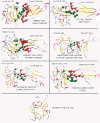Predicting domain-domain interaction based on domain profiles with feature selection and support vector machines
- PMID: 21034480
- PMCID: PMC2989984
- DOI: 10.1186/1471-2105-11-537
Predicting domain-domain interaction based on domain profiles with feature selection and support vector machines
Abstract
Background: Protein-protein interaction (PPI) plays essential roles in cellular functions. The cost, time and other limitations associated with the current experimental methods have motivated the development of computational methods for predicting PPIs. As protein interactions generally occur via domains instead of the whole molecules, predicting domain-domain interaction (DDI) is an important step toward PPI prediction. Computational methods developed so far have utilized information from various sources at different levels, from primary sequences, to molecular structures, to evolutionary profiles.
Results: In this paper, we propose a computational method to predict DDI using support vector machines (SVMs), based on domains represented as interaction profile hidden Markov models (ipHMM) where interacting residues in domains are explicitly modeled according to the three dimensional structural information available at the Protein Data Bank (PDB). Features about the domains are extracted first as the Fisher scores derived from the ipHMM and then selected using singular value decomposition (SVD). Domain pairs are represented by concatenating their selected feature vectors, and classified by a support vector machine trained on these feature vectors. The method is tested by leave-one-out cross validation experiments with a set of interacting protein pairs adopted from the 3DID database. The prediction accuracy has shown significant improvement as compared to InterPreTS (Interaction Prediction through Tertiary Structure), an existing method for PPI prediction that also uses the sequences and complexes of known 3D structure.
Conclusions: We show that domain-domain interaction prediction can be significantly enhanced by exploiting information inherent in the domain profiles via feature selection based on Fisher scores, singular value decomposition and supervised learning based on support vector machines. Datasets and source code are freely available on the web at http://liao.cis.udel.edu/pub/svdsvm. Implemented in Matlab and supported on Linux and MS Windows.
Figures






Similar articles
-
Prediction of contact matrix for protein-protein interaction.Bioinformatics. 2013 Apr 15;29(8):1018-25. doi: 10.1093/bioinformatics/btt076. Epub 2013 Feb 15. Bioinformatics. 2013. PMID: 23418186 Free PMC article.
-
PPI_SVM: prediction of protein-protein interactions using machine learning, domain-domain affinities and frequency tables.Cell Mol Biol Lett. 2011 Jun;16(2):264-78. doi: 10.2478/s11658-011-0008-x. Epub 2011 Mar 20. Cell Mol Biol Lett. 2011. PMID: 21442443 Free PMC article.
-
A computational model for predicting protein interactions based on multidomain collaboration.IEEE/ACM Trans Comput Biol Bioinform. 2012 Jul-Aug;9(4):1081-90. doi: 10.1109/TCBB.2012.55. IEEE/ACM Trans Comput Biol Bioinform. 2012. PMID: 22508910
-
A survey on computational models for predicting protein-protein interactions.Brief Bioinform. 2021 Sep 2;22(5):bbab036. doi: 10.1093/bib/bbab036. Brief Bioinform. 2021. PMID: 33693513 Review.
-
Prediction of Protein-Protein Interactions by Evidence Combining Methods.Int J Mol Sci. 2016 Nov 22;17(11):1946. doi: 10.3390/ijms17111946. Int J Mol Sci. 2016. PMID: 27879651 Free PMC article. Review.
Cited by
-
Prediction of contact matrix for protein-protein interaction.Bioinformatics. 2013 Apr 15;29(8):1018-25. doi: 10.1093/bioinformatics/btt076. Epub 2013 Feb 15. Bioinformatics. 2013. PMID: 23418186 Free PMC article.
-
A Computational Predictor for Accurate Identification of Tumor Homing Peptides by Integrating Sequential and Deep BiLSTM Features.Interdiscip Sci. 2024 Jun;16(2):503-518. doi: 10.1007/s12539-024-00628-9. Epub 2024 May 11. Interdiscip Sci. 2024. PMID: 38733473
-
Inference of protein-protein interaction networks from multiple heterogeneous data.EURASIP J Bioinform Syst Biol. 2016 Feb 19;2016(1):8. doi: 10.1186/s13637-016-0040-2. eCollection 2016 Dec. EURASIP J Bioinform Syst Biol. 2016. PMID: 26941784 Free PMC article.
-
Completing sparse and disconnected protein-protein network by deep learning.BMC Bioinformatics. 2018 Mar 22;19(1):103. doi: 10.1186/s12859-018-2112-7. BMC Bioinformatics. 2018. PMID: 29566671 Free PMC article.
-
Enhancing interacting residue prediction with integrated contact matrix prediction in protein-protein interaction.EURASIP J Bioinform Syst Biol. 2016 Oct 22;2016(1):17. doi: 10.1186/s13637-016-0051-z. eCollection 2016 Dec. EURASIP J Bioinform Syst Biol. 2016. PMID: 27818677 Free PMC article.
References
-
- Uetz P, Giot L, Cagney G, Mansfield TA, Judson RS, Knight JR, Lockshon D, Narayan V, Srinivasan M, Pochart P, Qureshi-Emili A, Li Y, Godwin B, Conover D, Kalbfleisch T, Vijayadamodar G, Yang M, Johnston M, Fields S, Rothber JA. A comprehensive analysis of protein-protein interactions in Saccharimyces cerevisiae. Nature. 2000;403:623–627. doi: 10.1038/35001009. - DOI - PubMed
-
- Patel T, Liao L. Predicting protein-protein interaction using Fisher scores extracted from domain profiles. Proceedings of IEEE 7th International Symposium for Bioinformatics and Bioengineering (BIBE); Boston, MA. 2007. pp. 946–951. full_text.
MeSH terms
Substances
LinkOut - more resources
Full Text Sources
Research Materials

